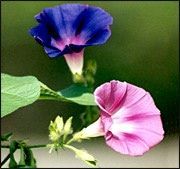Whether you accept it, avoid it or live somewhere in between, insurance coverage has become a defining issue for our profession. Patients increasingly expect to use their benefits, practitioners want to be compensated fairly for their time and expertise, and the system itself remains – at best – fragmented. The encouraging news is that coverage has expanded in meaningful ways. The challenging news is that reimbursement, across the board, remains inadequate.
Herbs & Botanicals
Pharbitis Seed (qian niu zi)
What is pharbitis seed? What is it used for?
Pharbitis seed comes from the pharbitis (also known as the morning glory), an annual climbing herb that many people use as an ornamental plant. Known for its beautiful flowers that bloom in the summer, pharbitis seed is harvested when the plant's fruit ripens. The seeds are dried in the sun, then used raw or after being parched.
Pharbitis seed is considered bitter, cold and somewhat toxic, and is affiliated with the Lung, Kidney, Small Intestine, and Large Intestine meridians. It promotes diuresis, and thus is employed to remove stagnant food and excess water. It also treats coughing, dyspnea and abdominal pain. Several formulas also incorporate pharbitis to treat a variety of digestive problems.
How much pharbitis seed should I take?
 The typical dose of pharbitis seed is between 3 and 6 grams, decocted in water. Smaller doses (1.5-4.5 grams) are recommended if being used in pill or powder form.
The typical dose of pharbitis seed is between 3 and 6 grams, decocted in water. Smaller doses (1.5-4.5 grams) are recommended if being used in pill or powder form.
What types of pharbitis seed are available?
Whole pharbitis seed can be found at some herbal markets and specialty stores. It can also be ground into a powder and used in pills, capsules and tablets. Pharbitis seed is occasionally ground down with other herbs to create an infusion.
What can happen if I take too much pharbitis seed? Are there any interactions I should be aware of? What precautions should I take?
Pharbitis seed is considered mildly toxic. Large doses may cause vomiting, abdominal pain and/or diarrhea, and may also harm the kidneys. Because of its toxic properties, pharbitis should be avoided by pregnant women and women who are breastfeeding. In addition, it should not be taken in conjunction with croton seed.
As of this writing, there are no well-known drug interactions associated with pharbitis seed. As always, make sure to consult with a licensed health care provider before taking pharbitis seed or any other herbal remedy or dietary supplement.
References
- Ha SC, Min K, Koo JC, et al. Crystallization and preliminary crystallographic studies of an antimicrobial protein from pharbitis nil. Acta Crystallogr D Biol Crystallogr February 2001;57(Pt 2):263-5.
- Ma H, Chen Y, Liu Y. An epidemiological study on the risk factors of irritable bowel syndrome in Zhanjiang, Guangdong province. Zhonghua Liu Xing Bing Xue Za Zhi December 2001;22(6):452-4.
- Nitasaka E. The Japanese morning glory as a model plant. Tanpakushitsu Kakusan Koso September 2002;47(12 Suppl):1488-93.
- Tsai JC, Tsai S, Chang WC. Comparison of two Chinese medical herbs, huang bai and qian niu zi, on influence of short circuit current across the rat intestinal epithelia. J Ethnopharmacol July 2004;93(1):21-5.
- Van Tassel DL, Roberts N, Lewy A, et al. Melatonin in plant organs. J Pineal Res August 2001;31(1):8-15.


